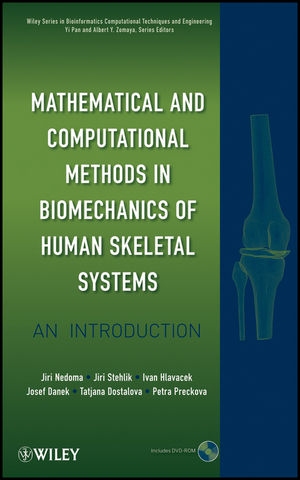Mathematical and Computational Methods and Algorithms in Biomechanics: Human Skeletal SystemsISBN: 978-0-470-40824-7
Hardcover
592 pages
September 2011
 |
||||||
ACKNOWLEDGMENTS.
PART I ANATOMY, BIOMECHANICS, AND ALLOARTHROPLASTY OF HUMAN JOINTS.
1 BIOMECHANICS OF THE HUMAN SKELETON ANDTHE PROBLEM OF ALLOARTHROPLASTY.
1.1 Introduction to History of Biomechanics and Alloarthroplasty.
1.2 Biomechanics of Human Joints and Tissues.
2 INTRODUCTION TOTHE ANATOMY OF THE SKELETAL SYSTEM.
2.1 Anatomy of the Skeletal System.
2.2 Human Joints and Their Functions.
2.3 Tribology of Human Joints.
2.4 Biomechanics of the Skeletal System.
3 TOTAL REPLACEMENT OF HUMAN JOINTS.
3.1 View of Arthroplasty Developments.
3.2 Static and Dynamic Loading of Human Joint Replacements.
3.3 Mechanical Destruction of Implants and Demands on Human Joint Arthroplasty.
3.4 Biomaterials in Ostheosynthesis and Alloarthroplasty.
3.5 Artificial Joint Replacements.
PART II MATHEMATICAL MODELS OF BIOMECHANICS.
4 BACKGROUND OF BIOMECHANICS.
4.1 Introduction.
4.2 Fundamentals of Continuum Mechanics.
4.3 Background of the Static and Dynamic Continuum Mechanics in Different Rheologies.
4.4 Background of the Quasi-Static and Dynamic Continuum Mechanics in Thermo(visco)elastic Rheology.
5 MATHEMATICAL MODELS OF PARTICULAR PARTS OF THE HUMAN SKELETON AND JOINTS ANDTHEIR REPLACEMENTS BASED ON BOUNDARY VALUE PROBLEM ANALYSES.
5.1 Introduction.
5.2 Mathematical Models of Human Joints and of Their Total Replacements asWell as of Parts of the Human Body.
5.3 Mathematical Models of Human Body Parts and Human Joints and Their Total Replacements Based on the Boundary Value Problems in (Thermo)elasticity.
5.4 Biomechanical Model of a Long Bone.
5.5 Mathematical Model of a Loaded Long Bone Based on Composite Biomaterials.
5.6 Stochastic Approach.
5.7 Mathematical Model of Heat Generation and Heat Propagation in the Neighborhood of the Bone Cement. Problems of Bone Necrosis.
6 MATHEMATICAL ANALYSES AND NUMERICAL SOLUTIONS OF FUNDAMENTAL BIOMECHANICAL PROBLEMS.
6.1 Background of Functional Analysis, Function Spaces, and Variational Inequalities.
6.2 Variational Equations and Inequalities and Their Numerical Approximations.
6.3 Biomechanical Models of Human Joints and Their Total
Replacements.
6.4 Stress–Strain Analysis of Total Human Joint Replacements in Linear, Nonlinear, Elasticity, and Thermoelasticity: Static Cases, Finite Element Approximations, Homogenization and Domain Decomposition Methods, and Algorithms.
6.5 Stress–Strain Analyses of Human Joints and Their Replacements Based on Quasi-Static and Dynamic Multibody Contact Problems in Viscoelastic Rheologies.
6.6 Algorithms.
6.7 Viscoplastic Model of Total Human Joint Replacements.
6.8 Optimal Shape Design in Biomechanics of Human Joint Replacements.
6.9 Worst-Scenario Method in Biomechanics of Human Joint Replacements.
6.10 Biomechanical Models of Human Joint Replacements Coupling Bi- and Unilateral Contacts, Friction, Adhesion, and Wear.
PART III BIOMECHANICAL ANALYSES OF PARTICULAR PARTS OF THE HUMAN SKELETON, JOINTS, AND THEIR REPLACEMENTS.
7 BIOMECHANICAL MODELS BASED ON CONTACT PROBLEMS AND BIOMECHANICAL ANALYSES OF SOME HUMAN JOINTS,THEIR TOTAL REPLACEMENTS, AND SOME OTHER PARTS OF THE HUMAN SKELETON.
7.1 Introduction to the Biomechanics of Statically Loaded and of Moving Loaded Human Body.
7.2 Bone Remodeling and the Corresponding Mathematical Model.
7.3 Biomechanical Studies of Cysts, Osteophytes, and of Inter- and Subtrochanteric Osteotomy of the Femur and the Knee Joint.
7.4 Biomechanical Analysis of the Loosened Total Hip Arthroplasty (THA).
7.5 Biomechanical Analysis of the Hip Joint after THA Implanting and Subtrochanteric Osteotomy Healing.
7.6 Analysis of Loaded Tubular Long Bone Filled with Marrow Tissue.
7.7 Numerical Analysis of theWeight-Bearing Total Knee Replacement; Analysis of Effect of Axial Angle Changes onWeight-bearing Total Knee Arthroplasty.
7.8 Total Knee Replacement with Rotational Polyethylene Insert.
7.9 Computer-Assisted Surgery in Orthopedics: A Perspective.
7.10 Biomechanical and Mathematical Models of the Thoracolumbal Spine.
7.11 Biomechanical and Mathematical Models of Joints of the Upper Limbs.
7.12 Mathematical and Biomechanical Analyses of the Temporomandibular Joint.
APPENDIX.
A.1 List of Notations.
A.2 Cartesian Tensors.
A.3 Some Fundamental Theorems.
A.4 Elementary Inequalities.
A.5 Finite Element Method.
REFERENCES.
INDEX.



